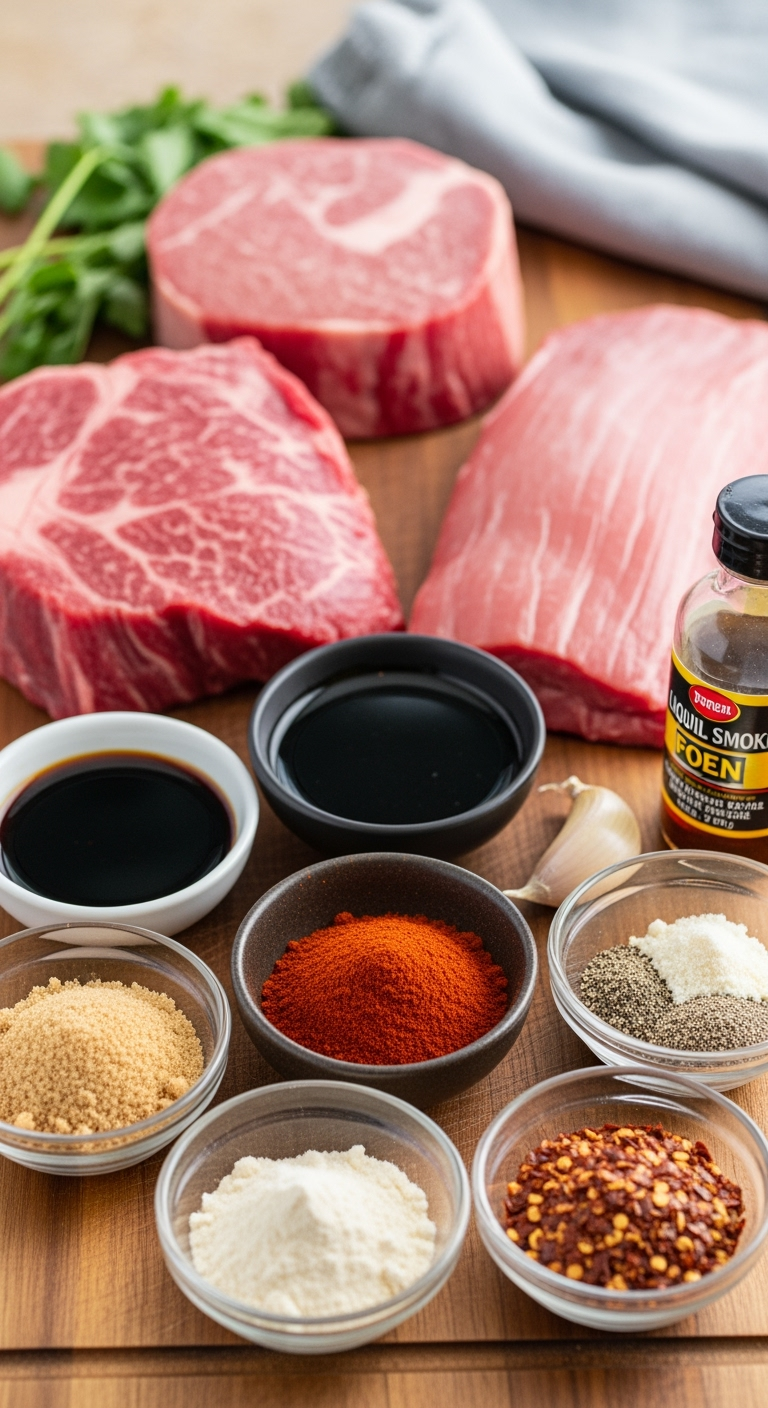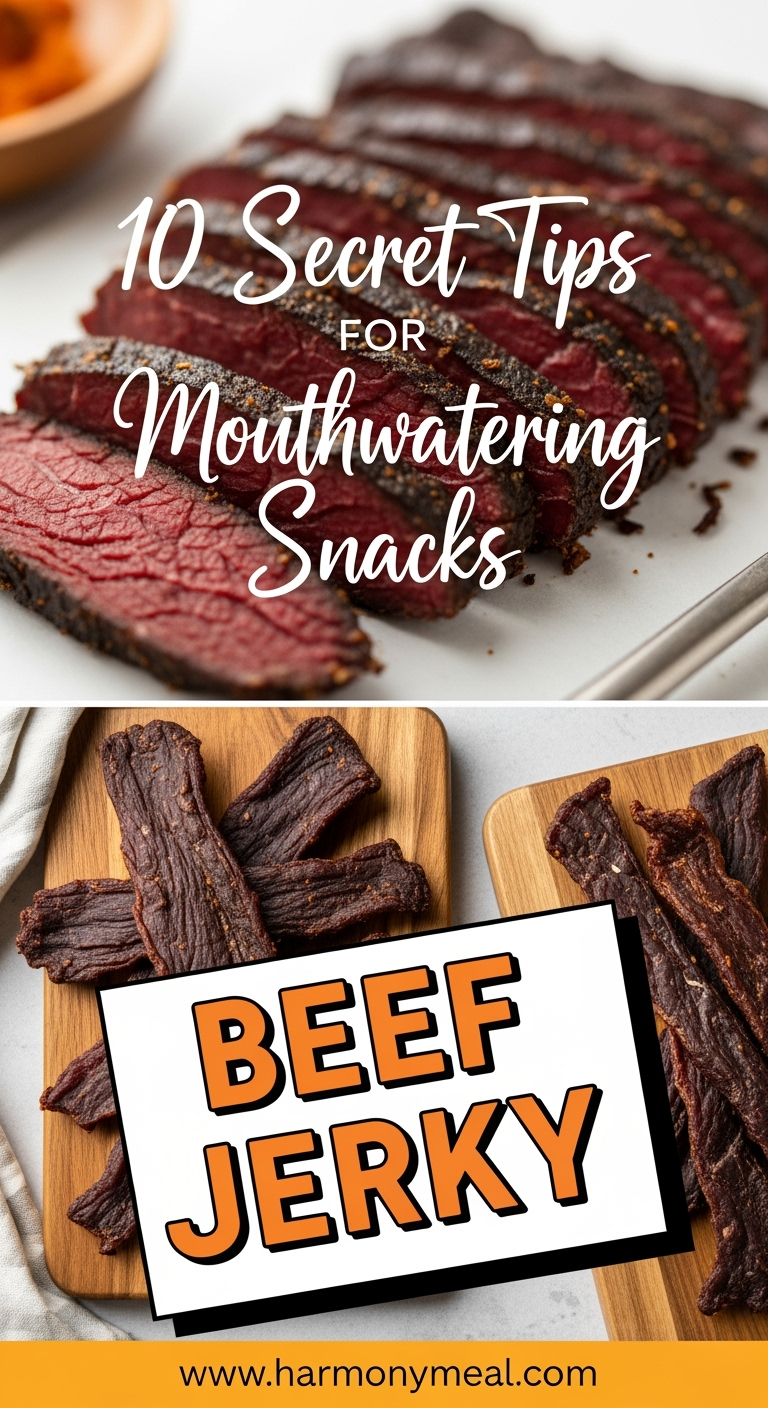Have you ever wondered why store-bought beef jerky costs nearly $35 per pound, while you can make it at home for less than half that? That’s exactly what hit me one Saturday afternoon while staring at a tiny $8 bag of beef jerky at my local grocery store. Making homemade beef jerky became my weekend mission after that eye-opening moment. The chewy, savory goodness of perfectly dried beef jerky has been a staple in my family’s snack rotation ever since I mastered the technique five years ago.
Beef jerky isn’t just a convenient protein source—it’s a connection to our past. For centuries, people have been preserving meat through drying, and there’s something deeply satisfying about continuing this tradition in our modern kitchens. Whether you’re looking for a protein-packed hiking companion, a gym-bag essential, or just a delicious snack for movie night, homemade beef jerky delivers exceptional flavor without the commercial preservatives.
Let me walk you through how to transform ordinary cuts of beef into extraordinary jerky that will have friends and family begging for your secret recipe.
Table of Contents
Ingredients for Perfect Beef Jerky
Beef jerky starts with choosing the right cut of meat and building a flavor profile that balances salt, sweetness, and spice. The beauty of homemade jerky is controlling exactly what goes into your marinade, ensuring it’s free from unnecessary additives and perfectly suited to your taste preferences.

- 2 pounds of lean beef (eye of round, top round, or flank steak)
- 1/3 cup soy sauce or coconut aminos
- 2 tablespoons Worcestershire sauce
- 2 tablespoons brown sugar or honey
- 1 tablespoon smoked paprika
- 2 teaspoons freshly ground black pepper
- 1 teaspoon garlic powder
- 1 teaspoon onion powder
- 1 teaspoon liquid smoke (optional)
- 1/2 teaspoon red pepper flakes (adjust to taste)
- 1/4 teaspoon Prague Powder #1 (optional, for longer shelf life)
For those watching sodium intake, you can use low-sodium soy sauce. Vegetarians haven’t been forgotten—mushroom jerky makes an incredible alternative using large portobello caps sliced thinly. The earthy, meaty flavor of mushrooms takes on marinade beautifully for a plant-based version of this classic snack.
Timing for Success
- Prep time: 30 minutes (plus 3-24 hours marinating time)
- Drying time: 4-8 hours (depending on thickness and method)
- Total time: 5-33 hours
While beef jerky requires patience, most of the time is hands-off. The actual active preparation is surprisingly quick—just 30 minutes to trim and slice the meat, mix the marinade, and get everything ready for drying. This is about 75% less active time than many people expect!
Step-by-Step Instructions for Making Beef Jerky
The process of making beef jerky isn’t complicated, but it does require attention to detail. Follow these steps for consistently perfect results every time:
1. Prepare the Meat
Freeze the beef for about 1-2 hours until firm but not solid. This makes slicing much easier and helps achieve consistent thickness. Trim all visible fat—fat doesn’t dehydrate properly and can make your beef jerky spoil faster. Slice the meat against the grain for tender jerky (or with the grain if you prefer a chewier texture) into strips about 1/8 to 1/4 inch thick.
2. Mix the Marinade
Combine all marinade ingredients in a large bowl or ziplock bag, stirring until the sugar dissolves completely. Add the sliced beef, making sure each piece is thoroughly coated. Seal and refrigerate for at least 3 hours, preferably overnight. The longer it marinates, the more flavorful your beef jerky will be.
3. Prepare for Drying
Remove the beef from the marinade and pat each piece dry with paper towels. This step is crucial—excess moisture extends drying time and can lead to uneven results. Arrange the strips in a single layer on your drying racks, making sure they don’t touch.
4. Dry the Beef Jerky
Using a food dehydrator: Set to 160°F and dry for 4-6 hours, checking periodically.
Using an oven: Preheat to the lowest setting (ideally 170°F or lower). Prop the door open slightly with a wooden spoon to allow moisture to escape. Place the meat on racks over baking sheets and dry for 4-8 hours.
The beef jerky is ready when it bends and cracks but doesn’t break. It should be dry to the touch but still somewhat pliable—not brittle.
Nutritional Information for Beef Jerky
Homemade beef jerky packs a powerful nutritional punch. A 1-ounce serving (about 28g) contains approximately:
- Calories: 80-100
- Protein: 13-15g
- Carbohydrates: 3-5g
- Fat: 1-3g
- Sodium: 400-600mg (varies based on marinade)
Beef jerky delivers an impressive protein-to-calorie ratio, making it ideal for athletes and active individuals. The high protein content helps with muscle recovery and provides sustained energy, while the low fat content makes it leaner than many other snack options.
Equipment Needed
Making beef jerky at home doesn’t require fancy equipment, though having the right tools certainly helps:
- Sharp knife or meat slicer
- Cutting board
- Large mixing bowl or gallon-sized ziplock bags
- Paper towels
- Food dehydrator OR oven with wire racks
- Baking sheets (if using oven method)
- Airtight containers for storage
A dedicated food dehydrator makes beef jerky production more consistent and energy-efficient, but a standard home oven works perfectly well for occasional jerky making. If you’re using the oven method, positioning a fan nearby can help circulate air and speed up the drying process.
Why You’ll Love This Beef Jerky Recipe
There’s something deeply satisfying about making your own beef jerky that goes beyond the obvious cost savings. Here’s why this recipe deserves a spot in your regular rotation:
- Complete control over ingredients means no preservatives, excess sodium, or mysterious additives
- Customizable flavors let you adjust spice levels, sweetness, and umami to your exact preferences
- Batch cooking creates weeks of high-protein snacks in a single session
- The process is surprisingly simple once you learn the basics
- Homemade beef jerky makes thoughtful gifts for fitness enthusiasts, hikers, or anyone who appreciates quality food
My brother-in-law, who regularly hikes sections of the Appalachian Trail, swears by my homemade beef jerky as his go-to trail food. The concentrated protein and calories in a lightweight, non-perishable form make it ideal for outdoor adventures.
Healthier Alternatives for Beef Jerky
While traditional beef jerky is relatively healthy as snacks go, there are several ways to adapt this recipe for specific dietary needs:
- For lower sodium: Reduce soy sauce by half and increase spices to maintain flavor depth
- For sugar-free versions: Substitute monk fruit sweetener or erythritol for brown sugar
- For paleo/whole30: Use coconut aminos instead of soy sauce and omit the sugar completely
- For different proteins: Try turkey, venison, or bison for leaner alternatives to beef
- For heat lovers: Double the red pepper flakes or add 1-2 teaspoons of cayenne
A client of mine following a strict keto diet uses this same technique with lean ground beef pressed flat and then cut into strips—an affordable hack when round steak prices climb too high.
Serving Suggestions for Beef Jerky
Beef jerky stands perfectly well on its own, but it can also enhance other dishes:
- Chop finely and add to scrambled eggs for a protein boost
- Use as a savory topping for salads instead of bacon
- Pair with aged cheddar and apple slices for a balanced snack plate
- Add to trail mix with nuts and unsweetened dried fruits
- Serve alongside pickled vegetables for a no-cook appetizer plate
During football season, I set out a jerky board with different flavors labeled for guests to sample—spicy, sweet, teriyaki, and classic. It’s always the first snack to disappear!
Common Mistakes to Avoid with Beef Jerky
Even experienced cooks can run into trouble with beef jerky. Here are the pitfalls to watch for:
- Leaving too much fat on the meat can lead to rancidity and shorter shelf life
- Slicing inconsistently results in some pieces overdrying while others remain too moist
- Over-marinating (beyond 24 hours) can make the texture too mushy
- Drying at temperatures below 160°F may not kill potential bacteria
- Underdrying creates a food safety risk, while overdrying makes jerky too brittle
The most critical mistake I’ve seen is impatience during the drying process. When I first started making beef jerky, I pulled a batch too early and had to discard it after mold appeared within days—a costly lesson in food safety!
Storing Tips for Beef Jerky
Proper storage extends the life of your homemade beef jerky and maintains its quality:
- Cool completely before storing to prevent condensation
- Store in airtight glass containers or vacuum-sealed bags
- Keep at room temperature for 1-2 weeks
- Refrigerate for up to 3 months
- Freeze for up to 6 months in vacuum-sealed bags
Adding oxygen absorber packets (available online) to your storage containers can dramatically extend shelf life by preventing oxidation, which leads to staleness. I divide large batches into weekly portions, keeping one in the pantry and the rest in the freezer.
Conclusion
Making beef jerky at home transforms an everyday protein into something extraordinary. The process connects us to food preservation traditions that span cultures and centuries, while delivering a convenient modern snack that fits active lifestyles.
What began as my quest to save money on expensive store-bought jerky has become a beloved kitchen ritual that friends and family count on. The satisfaction of creating something so fundamental yet so flavorful from scratch never gets old.
Ready to try your hand at homemade beef jerky? Start with this basic recipe, then experiment with flavors once you’ve mastered the technique. Your hiking packs, gym bags, and snack drawers will never be the same!
Don’t forget to check out HarmonyMeal’s protein-packed snack ideas for more inspiration to fuel your active lifestyle.
FAQs About Beef Jerky
Can I use ground beef to make jerky?
Yes. Use very lean ground beef (93%+), mix seasonings thoroughly, and form even strips with a jerky gun. Ensure the meat reaches 160°F for safety before or during drying.
How do I know when my beef jerky is done?
It should bend and crack but not break. The surface feels dry, not sticky, and no moisture squeezes out. If in doubt, dry a little longer.
Is curing salt required?
No for short-term storage if you dry at 160°F or higher. Prague Powder #1 is optional and helps extend shelf life and add a safety margin.
Why is my jerky too tough?
Likely sliced with the grain, cut too thin, or over-dried. Next time slice against the grain, keep slices 1/8–1/4 inch, and monitor doneness closely.
Can I reuse the marinade?
No. Discard marinades that touched raw meat to avoid food safety risks. Make a fresh batch if needed.
Beef Jerky Secrets You Need to Try for the Perfect Snack
Save big and snack smarter with this easy homemade beef jerky. Balanced sweet–savory–smoky flavor, tender chew, and clean ingredients—perfect for hikes, gym bags, or movie night.
- Prep Time: 30 minutes (plus 3–24 hours marinating)
- Cook Time: 4–8 hours
- Total Time: 5–33 hours (mostly hands-off)
- Yield: About 10–12 oz jerky (from 2 lb beef) 1x
- Category: Snack
- Method: Dehydrating
- Cuisine: American
Ingredients
- 2 pounds lean beef (eye of round, top round, or flank steak)
- 1/3 cup soy sauce or coconut aminos
- 2 tablespoons Worcestershire sauce
- 2 tablespoons brown sugar or honey
- 1 tablespoon smoked paprika
- 2 teaspoons freshly ground black pepper
- 1 teaspoon garlic powder
- 1 teaspoon onion powder
- 1 teaspoon liquid smoke (optional)
- 1/2 teaspoon red pepper flakes (to taste)
- 1/4 teaspoon Prague Powder #1 (optional, for longer shelf life)
Notes: Use low-sodium soy if desired. Vegetarian swap: make mushroom jerky with thinly sliced portobellos.
Instructions
- Prep the meat: Freeze 1–2 hours until firm for easier slicing. Trim all visible fat. Slice 1/8–1/4 inch thick against the grain for tender jerky (with the grain for chewier).
- Marinate: Whisk all marinade ingredients until sugar dissolves. Add beef, coat thoroughly, and refrigerate 3–24 hours (overnight best). Turn once.
- Set up to dry: Remove beef and pat very dry with paper towels. Arrange in a single layer on dehydrator trays or wire racks over sheet pans; pieces should not touch.
- Dry: Dehydrator 160°F for 4–6 hours. Oven lowest setting (ideally 170°F or lower) with door slightly ajar for airflow, 4–8 hours. Rotate trays as needed.
- Doneness test: Jerky should bend and crack but not snap; dry to the touch, not sticky. If moisture appears when bent, continue drying.
- Cool & store: Cool completely to avoid condensation, then pack airtight. See storage notes.
Notes
Approx per 1 oz: 90 kcal, 14g protein, 4g carbs, 2g fat, 500mg sodium (varies by marinade). Storage: room temp 1–2 weeks (airtight), fridge up to 3 months, freezer up to 6 months (vacuum-sealed). Optional curing salt (Prague Powder #1) adds safety & shelf life; skip for short-term use. Safety tip: keep drying temp at/above 160°F. Pro tips: slice evenly; pat very dry before drying; don’t over-marinate (>24h) to avoid mushy texture.
Nutrition
- Serving Size: 1 oz (28g)
- Calories: 90
- Sugar: 3g
- Sodium: 500mg
- Fat: 2g
- Saturated Fat: 1g
- Unsaturated Fat: 1g
- Trans Fat: 0g
- Carbohydrates: 4g
- Fiber: 0g
- Protein: 14g
- Cholesterol: 25mg
Keywords: beef jerky, homemade beef jerky, dehydrator jerky, oven jerky, Prague Powder #1, high protein snack, mushroom jerky
Follow & Join the Harmony Meal Community
📌 Love indulging in rich and cheesy comfort food?
Get inspired with more crave-worthy breakfasts, comforting dinners, and irresistible desserts.
👉 Follow us on Pinterest for easy-to-save recipes and meal ideas you’ll actually want to make.
📘 Let’s be foodie friends!
Join our community of passionate home cooks and flavor chasers.
👉 Follow Harmony Meal on Facebook to share your own dishes, get exclusive content, and connect with others who love to eat and create.


